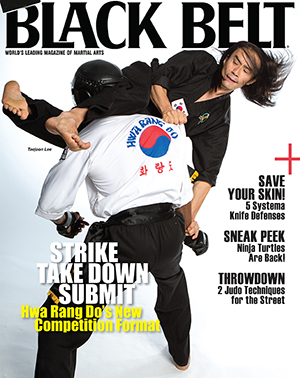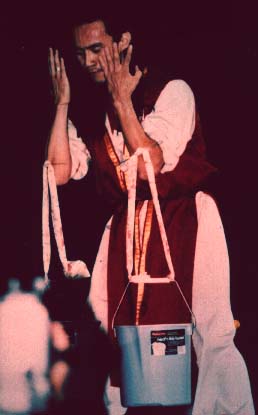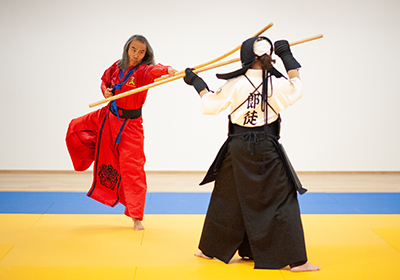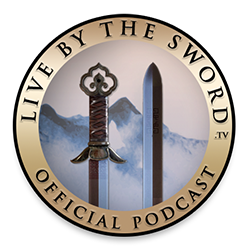
Hwa Rang Do®
"The Way of the Flowering Knights"
Hwa Rang Do is an 1800 year old Korean Martial and Healing Art system. Its theory is based on the Um-Yang principle, which states that all things within nature possess equal opposites and the state of balance of these opposing forces creates Harmony in one’s life. It is the most comprehensive martial art system in the world in existence today. It is a balance of both soft/circular and hard/linear principles of movement divided into four divisions.

Nae Gong
Development of internal energy, Ki Power, through meditation and breathing exercises.
It deals with one’s internal energy (Ki power) development, control and direction, through both passive (um) and active (yang) methods. Ki power development is taught via specialized breathing and meditation exercises in conjunction with specific physical exercises. The practitioner learns to develop, harness, and apply this human energy resources at will. Initially, it was studied for health purposes and for use in the battlefield; at more advance levels this power can be controlled in conjunction with mental processes and can be extended from one individual to another for healing as well as combative applications. This internal energy is the Life Force found in all living creatures and through the disciplined study of Hwa Rang Do® one can learn to develop this power for truly outstanding displays of human energy and will, extending previously conceived limitations to unlimited possibilities.
There are five different senses of Ki which can be developed after you practice Hwa Rang Do’s® ki(power) development exercises:
Kyung Ki – making the body light
Jung Ki – making the body heavy
Chyel Ki – making the body hard as steel
Ma Ki – making the body numb
Shin Ki – increasing mental concentration and awareness
 Wae Gong
Wae Gong
Development of External Powers through the practice of over 4,000 self-defense techniques, 365 kicking combinations in both hard/linear and soft/circular movements. The achievement of complete physical control.
It is the cultivation and development of external physical powers through the practice and training of over 4,000 offensive and defensive combative applications found within the art and it is the externalization of Nae Gong. Most martial arts are either tense and linear in their orientation or are soft and circular. However, Hwa Rang Do® combines both elements (Um and Yang), following the physical laws of the universe to create the most effective combative system which is both compatible and harmonious with nature.
This phase of instruction includes:
- All forms of hand strikes and blocks (trapping and grabbing as ell as deflection applications, using the hands, wrist, forearm, elbows, arms and shoulders)
- 365 individual kicks
- throws and falls from any position and onto any surface
- human anatomy & physiology as it pertains to combative applications (knowing and utilizing the body’s weak points to effectively control the opponent, regardless of their size)
- joint manipulation and/or bone breaking
- finger pressure point applications
- containment, control, and transport techniques
- grappling applications & submissions
- ground fighting and locks
- forms for each sash
- offensive choking/breaking techniques
- defense against multiple assailants
- counter-offense and defense for the above and additional advanced, secretive techniques
These applications are taught in their combative form, yet with full control in order to minimize danger to the student. By practicing these diverse aspects, one can regain and maintain health through physical exercise while learning to control any antagonist with one movement. Hwa Rang Do techniques are implemented to the degree a particular situation dictates, applying a particular degree of response for each incremental escalation of force. Within this division of Wae Kong you can find over 4,000 techniques in Hwa Rang Do®. These 4,000 techniques have both practical, effective ways and artistic ways of execution. Hence, it requires tremendous concentration and dedication in order learn and memorize our curriculum. Even though there are so many techniques, they are mostly designed so that it is easy for a physically weaker individual to perform them on a stronger opponent; anyone from 3 year old children to 80 year old adults can learn them.
 Shin Gong
Shin Gong
Development of Mental Concentration and Alertness through disciplined regiment, enhancing better focus. Also, the study of philosophy of martial way in order to apply its principles to everyday life.
It is the study, development, and control of the human mind in order to attain one's full potential and mental capabilities. Techniques are taught to achieve an increase in one's total awareness, focus, and concentration levels. This realm includes instruction in: controlling one's mind; extra sensory perception; development of the "sixth sense"; memory recall; understanding the natural laws of the universe; the study of human character and personalities; practical psychology; visualization; the art of concealment and stealth as utilized by special agents (Sulsa); as well as advanced, secretive applications. These powers and more lie within the potentials of every human being and can be developed and utilized through the proper training methods.
 Mu Gi Gong
Mu Gi Gong
Development of mastery of external objects. There are over 108 different weapons found in Hwa Rang Do.
It involves the offensive and defensive use of the over 108 traditional weapons found within 20 categories of weaponry. By learning these various weapon systems, the practitioner can most effectively utilize any object as a weapon as the situation demands.
- Cutting Weapons
- Slicing Weapons
- Chopping Weapons
- Stabbing Weapons
- Throwing Weapons
- Grappling Weapons
- Striking Weapons
- Shooting Weapons
- Blowing Weapons
- Hammering or Slugging Weapons
- Stick Weapons
- Sectioned Weapons
- Linked Weapons
- Fan Weapons
- Cane Weapons
- Ball or Round Weapons
- Spear Weapons
- Pin or Needle Weapons
- Sling Weapons
- Disk Weapons


